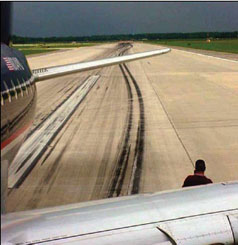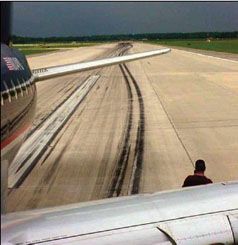Youve just made the perfect trip, capping it off with a smooth approach and touchdown. As your passengers congratulate you on your achievement, you relax back pressure on the yoke and firmly stomp on the brakes. In response, the nose dips and the airplane wants to dart off to the side. You relax pressure on the brakes, but youve missed the midfield turnoff and must roll to the next taxiway before you can turn back toward the ramp. Is that how you want your routine flights to end? Youve managed to smoothly navigate hundreds of miles, but are your ground-handling skills on the same level as your piloting? Do you understand what just happened? GIMME A BRAKE 288 Most pilots fly airplanes with two brakes, one on each main wheel. On airplanes equipped with free-castering nosewheels-the Cirrus and Grumman American types are examples-theyre used to steer the airplane on the ground in addition to controlling its speed. Other airplanes-Pipers, Cessnas, etc.-have steerable nosewheels and use the mainwheel brakes, along with a burst of power, to help them make small-radius turns on the ramp. Taildraggers, whether equipped with steerable tailwheels or not, are a slightly different matter. Regardless of how your airplane is equipped, how you use its brakes is a sign of how skilled a pilot you are. From almost the first dual-instruction session, pilots should be taught the proper ways to use the brakes on their airplane. While many are, many others seem to have forgotten those lessons. You know the type: Pilots who taxi slowly at a moderate power setting. Its obvious the pilot is holding the brakes to keep down the taxi speed when simply reducing power is the correct solution. Not only is that bad technique, it isnt good on the brakes. The sidebar on page 14 highlights another danger of taxiing with too much power and too much brake. Pre-flighting Brakes Ensuring you can control and stop the airplane when necessary begins with a thorough preflight of its brake system. This starts before you even get to the airport with a thorough review of your airplanes Pilots Operating Handbook (POH) or Airplane Flight Manual (AFM). Although details differ from manufacturer to manufacturer and type to type, at least a general description of the brake system can be found there. If youre lucky, youll find a detailed schematic of the brake system. At a minimum, however, the POH/AFM should detail the kind of fluid used in the system-usually Mil-H-5606 hydraulic/brake fluid-where the systems reservoir is located and how to replenish it. Thats a good thing, because thats the next thing you should be checking during your preflight. Locate the reservoir, and inspect it for leaks and security-its usually on the firewall in the engine compartment. Many reservoirs are made from a rather thin-walled ferrous metal can. These can rust, especially if theyre in an area of the airframe susceptible to moisture. Also, the screw-top caps on many of these cans are vented. Inspect the vent for any foreign material plugging it. The reservoir should be marked with a maximum fill line. Using fresh fluid from a clean container, bring the reservoir up to the fill line and replace the cap. While youre there, trace the line(s) running from the reservoir and check them for leaks and/or chafing. Usually, these lines are fabricated from small-diameter aluminum tubing and mounted using Adel (cushion) clamps. Any fittings attaching flexible hoses should also be inspected and checked for leaks. Any leaks of the red-colored 5606 should be noticed easily. Elsewhere, look for the brake lines extending out of the lower fuselage at the main gear mounting points (fixed-gear airplanes) or from within the main wheel wells (retractables). All retractable-gear brake lines weve seen consist of hard aluminum lines leading to a fitting and a flexible hose running to the brake. Again, trace these lines, fittings and hoses with your eyes and look for the telltale red fluid. See the sidebar on the opposite page for further recommendations on inspecting the brakes and brake pads. Effective Brake Use If you find yourself holding steady brake pressure on your airplane or even constantly stabbing at them to slow down or correct your trajectory, youre doing something wrong. The most likely thing youre doing is taxiing with too much power; other symptoms could be caused by trying to maneuver your airplane like its a motor vehicle. In both instances, youre using bad technique. Sometimes, of course, you cant help but use as much brake as is available. Examples include a downhill taxiway, taxiing before a stiff tailwind or upon touching down after a “too-fast” approach and landing. In these instances, avoid pulsing the brakes by pumping the pedals. Instead, apply steady, firm pressure-as much as you need, short of lock-up-and then release it, as appropriate. You dont want to pump the brakes for a variety of reasons, including the additional wear and tear on the master cylinder and caliper mechanisms. By applying steady, firm pressure, youre obtaining as much brake force as you can over the shortest time. Thats what will slow down the airplane most efficiently. The only time we can think of when pumping or pulsing the brakes might be beneficial is when the runway or taxiway is slippery from rain or winter weather. Alternately applying and releasing brake pressure can help prevent a wheel from locking up and causing a skid in those circumstances. Other times, firmly apply the brakes until the airplane slows to the desired speed. Before doing so, of course, power should be reduced to the bare minimum-it doesnt make much sense to keep a moderate amount of power when ones trying to stop or slow down. Ultimately, though, we believe the best way to use your airplanes brakes is rarely. This means taxiing slowly and using nosewheel steering, if available. It means flying final approaches “on speed” to eliminate too-high touchdown speeds and minimize runway length necessary. And it means looking ahead and planning ground operations to use minimal power and minimal braking. Maximum Braking What about maximum braking? Most light airplane brake systems are marginally effective, in our view, owing to their lightweight components, small-diameter brake rotors and simple systems. Which might be a good thing, since most tricycle-gear nosewheels are not as robust as we would like to think. The bottom line is that were not driving a new car equipped with ABS. Maximum braking, such as when playing short field landings for keeps, when aborting a takeoff or when someone or something suddenly appears in front of us on a runway, involves three things: minimum power, weight on the main wheels and firm, steady pressure on the brake pedals. For the former, it should be a no-brainer that maximum braking can only be achieved when power is reduced to the bare minimum. If you have to stop now, pull the throttle to the idle stop and leave it there. To get the most weight possible on the main wheels, we need to fully deflect the elevator control to the nose-up position. But we also need to be careful; applying maximum nose-up elevator at touchdown speed can increase the angle of attack to the point where the airplane wants to lift off again. The technique we learned was to firmly apply maximum braking first then, as the airplane decelerates, smoothly apply back elevator, ensuring the nosewheel remains on the ground. Finally, to achieve maximum braking, pressure must be applied to the pedals firmly while maintaining directional control. When trying to stop on a short runway, its best to fly the approach by the book, using the recommended short-field airspeed on final. Power should be reduced to idle as the mains touch down, the nosewheel lowered to assure directional control and maximum braking applied as full back elevator pressure is applied. Youll do fine.




